- Skip to content


Problem-solving workshop: Step-by-Step
A problem-solving workshop is held by the Agile Release Train and its purpose is to address systematic problems. The workshop that concentrates on identifying the problems, not just addressing the symptoms, is facilitated by the Release Train Engineer and time-boxed to maximum of two hours. What are the six steps of the workshop?
In SAFe® (Scaled Agile Framework for Enterprises®), problem-solving workshop is done during the Inspect & Adapt (I & A) event. I & A is held at the end of each Program Increment, and it forms the basis for relentless improvement, one of the four pillars of the SAFe House of Lean , and a dimension of the Continuous Learning Culture core competency.
During the three parts of I & A event (PI System Demo, Quantitative and Qualitative measurement, and Retrospective and problem-solving workshop), the ART demonstrates and evaluates the current state of the solution and teams reflect and identify improvement backlog items. In this article we are going to concentrate on the last part of the event, problem-solving workshop, during which teams systematically address the larger impediments that are limiting velocity.
Problem-solving workshop consists of 6 steps
Step 1: agree on the problem to solve.
Clearly stating the problem is key to problem identification and correction. It enables more focused investigation, time-saving, and avoids ‘ready, fire, aim’ approach. On the other hand, a problem that is not well defined, may result in failure to reach the proper countermeasure. To identify and agree on the problem to solve, the teams should spend a few minutes clearly stating the problem, highlighting the ‘what’, ‘where’, ‘when’, and ‘impact’ as succinctly as they can.
Step 2: Apply root-cause analysis and 5 whys
The Root-cause analysis and the ‘5 Whys’ technique is used to explore the cause-and-effect relationships underlying a particular problem. It helps to avoid assumptions and logic traps, trace the chain of causality in direct increments from the effect to a root cause.
The root cause analysis (fishbone or Ishikawa) diagram features 5 main ‘bones’ that represent typical sources of problems in development (tools, people, program, process, environment). Team members then brainstorm causes that they think contribute to the problem to be solved and group them into these categories. Once a cause is identified, its root cause is explored with the 5 Whys technique. By simply asking ‘why’ multiple times, the cause of the previous cause is uncovered, and added to the diagram. The process stops once a suitable root cause has been identified and the same process is then applied to the next cause (© Scaled Agile, Inc.).
Step 3: Identify the biggest root-cause using Pareto analysis
Team uses Pareto analysis (or 80/20 rule) to narrow down the number of actions that produce the most significant overall effect. It is based on the principle that 20% of root causes can cause 80% of problems and it has proved useful where many possible sources and actions are competing. Once the team writes down all the causes-of-causes, they identify the biggest root-cause using dot-voting – every team member has five dots on its disposal, and he can allocate them to one or more items he thinks are most problematic. Then they summarize votes in Pareto chart that shows collective consensus on the most significant root-cause.
Step 4: Restate the new problem for the biggest root-cause
Team picks the most voted item from Pareto chart. They restate it clearly as a problem and add economic impact of the problem to the description.
Step 5: Brainstorm solutions
During the brainstorming activity that lasts about 15 – 30 minutes, team brainstorms as many possible corrective actions as possible. The goal of activity is to generate as many ideas as possible, without criticism or debate. Team members should let their imagination soar and explore and combine all the ideas that arise and in the end dot-vote to identify top contenders.
Step 6: Identify improvement backlog items (NRFs)
In the end of the problem-solving workshop, up to three most voted solutions are identified. Solutions are then rephrased as improvement stories and features to be fed directly into the PI Planning event that follows the I & A event. During that event, the RTE helps ensure that the relevant work needed to deliver the identified improvements is planned. This closes the loop, thus ensuring that action will be taken, and that people and resources are dedicated as necessary to improve the current state. In this way, problem-solving becomes routine and systematic, and team members and ART stakeholders can be assured that the train is solidly on its journey of relentless improvement (© Scaled Agile, Inc. ).
You may also like

Mastering SAFe: What Every Business Professional Should Know

Anti-Patterns in SAFe Implementation
{{ ftc.framework.name }}
Your email address is used to securely create and identify your SAFe® Collaborate account so that you can access the data created when you participate in SAFe® Events . Your email is not stored until you give consent.
Forgot password?
Learn more about SAFe® Studio access and benefits, including access to this and other advanced collaboration templates and much more.
- SAFe® Community
- SAFe® Support
- Privacy Policy

- Practice Exam
Navigating the Inspect & Adapt Workshop: The Key to Continuous Improvement in SAFe
0 Comments
In the dynamic world of Agile, the Inspect & Adapt Workshop stands as a cornerstone in the Scaled Agile Framework (SAFe). It’s a pivotal moment where Agile teams converge to reflect, learn, and plan for the future. But what exactly are the outcomes of this workshop? Today, let’s delve into the heart of this process and understand why “Identifying and prioritizing process improvements” is not just an option, but the primary outcome of the Inspect & Adapt Workshop.

The Essence of the Inspect & Adapt Workshop
At its core, the Inspect & Adapt (I&A) Workshop is a structured problem-solving session. It marks the end of the Program Increment (PI) and serves as a critical reflection point. Teams gather to inspect their achievements and adapt their processes, learning from their experiences. It’s not just about what we did, but how we did it and how we can do it better.
Why Process Improvement is Key
Among the options provided – creation of user stories, release of the product to customers, and setting the agenda for the next PI – identifying and prioritizing process improvements stands out. Why? Because continuous improvement is the lifeblood of Agile. While releasing products and creating user stories are essential, they are part of the ongoing Agile process. The I&A Workshop’s unique contribution is its focus on elevating the process itself.
Real-Life Application
Imagine a team working on a software development project. They’ve had a successful PI, with several user stories completed and features shipped. However, during the I&A Workshop, they realize that certain bottlenecks in communication slowed them down. By identifying and addressing these issues, the team sets the stage for more efficient sprints in the future, ultimately leading to better products and happier customers.
The Inspect & Adapt Workshop is more than a routine meeting; it’s an opportunity for genuine growth. By focusing on process improvements, SAFe practitioners ensure that their Agile journey is not static but a path of continuous evolution and enhancement
You may also like
The three skills of an effective safe scrum master: communication, coordination, cooperation, building trust in planning: the team’s commitment in safe, get in touch.
Session expired
Please log in again. The login page will open in a new tab. After logging in you can close it and return to this page.
[email protected]
+91 9036707847
Recent Posts
- Snowflake Learning Path: A Compreh..
- Artificial Intelligence, Automatio..
- The Future of AI in Education: Rev..
- Artificial Intelligence and the Fu..
- Do's and Don'ts in Programmatic Ad..
- Best Programmatic Advertising Plat..
- Top 12 Professional Programmatic A..
- Challenges of Programmatic Adverti..
- Salesforce Marketing Cloud Platfor..
- Programmatic Ad Buying: A Comprehe..
Inspect and Adapt in Scaled Agile Framework
The Scaled Agile Framework is a grouping of patterns for organization and workflow developed to help enterprises scale Lean and Agile development practices. This is one of the most popular frameworks whose objective is to help organizations face the challenges in their effort to scale Agile beyond one team. Agile teams work through a regular feedback system, and feedback comes in many ways. One way is receiving product feedback at the end of every iteration when the iteration review is done. Another way of receiving feedback is during the iteration retrospective, where there is an opportunity to review and improve people and processes. Through this continuous feedback, teams keep improving and improving, which helps them build better products.
But in SAFe, many teams work together on one product. So, the Agile Release Train (ART) also needs to get into a feedback system. There are many principles, practices, and events within the Scaled Agile Framework; if not all, most are used when large-scale product production. For example, events like iteration reviews and retrospectives in SAFe occur after the end of the iterations. Inspect and Adapt Scaled Agile Framework is also an event that happens at the end of a Program Increment (PI). Here, we will provide all the details about the SAFe Agile Inspect and Adapt (I&A), including what happens.
What is Scaled Agile Inspect and Adapt?
Described by Scaled Agile as "a significant event that is held at the end of each Program Iteration," Inspect and Adapt is a crucial feature of SAFe, where PI is a timeboxed event that is usually of 8 to 12 weeks duration. As the name suggests, it is an event to inspect the product's progress and condition and adapt to the new features. The purpose of a PI is to enable the Agile Release Train to deliver incremental value at the end of this event which is in the form of a working and tested product or service. This value may be some features of the product or service. And the I&A event is held at the end of each PI so that developers can show at what stage the product development has reached and what process was used to reach this condition. The ART then evaluates the product. This is followed by a structured problem-solving workshop where teams ponder and identify the improvement backlog items. The I&A event is crucial because it gives the ART a chance to thoroughly inspect both the product and the process, which helps ensure that the following PI would be better. Thorough inspection and efforts to improve both the product and the process will pave the way for a better PI the next time.
The event is attended by all the Stakeholders in the Agile Release Train, provides a set of improvement backlog items added to the next PI planning event, and helps the ART improve all the subsequent PIs. Solution trains hold a similar I&A event for large solutions.
Principle of Inspect and Adapt
The basis of the SAFe Lean-Agile strategy is the concept mentioned in the Agile manifesto that states, "continuous improvement is essential ." The teams take time at the pre-decided intervals to contemplate how they can become more effective and efficient. Based on the derived thoughts, they change or modify their behaviors accordingly. This focus on continuous improvement and the experience gathered through the development cycle, along with the repeated review, enhances the teams' ability to find different viewpoints and multiple ways to do one task. So, the I&A event is an ideal chance for the teams to reflect on what has gone wrong so far, the mistakes that have been committed, and the ways to prevent them from happening again. This is further bolstered by the feedback received from different sources that helps them improve the product and the process. The result is an overall improvement in the speed, quality, and reliability of the following PI. So, it is essential to be set apart to think about how teams can improve.
The Scaled Agile Framework Inspect and Adapt process:
Being an essential element of SAFe, the I&A process drives continuous development with the help of team evaluation and Stakeholder inputs. A team can make continuous progress if a mindset of inspection and adaptation is adopted. All people involved in developing the solution should ideally participate in the I&A event. These include:
The Agile teams
Release Train Engineers (RTEs)
System and solution architects/ Engineers
Product management
Business owners and others in the ART
The I&A event works in three parts. They are:
The PI system demonstration - Analyzing and customizing the product
Qualitative and quantitative measurement - Analyzing the process with the help of metrics
Retrospectives and workshop on problem-solving strategies - Customizing the process
We will now discuss each part in detail.
The PI system demo:
This is the first part of Inspect and Adapt process. It is the demonstration of the system developed during the PI. Here, product development facilitates demonstration covering the fully integrated system. This system demo is a biweekly event but differs from the system demos held at the end of every PI. This demo aims to demonstrate all the features developed by the ART during the just concluded PI. The ultimate goal is to display the existing condition of the system and the progress it has made. The audience here is much broader than the normal PIs and includes business owners, Stakeholders, sponsors, portfolio representatives, and customer representatives. All these collaborate with every Agile team to assess how much business value has been delivered. So, this demo takes a more formal shape and needs extra preparation and staging. Despite this, the PI system demo is time-bound, like other demos, usually limited to, at the most, one hour. An exception can be made for Stakeholders to remain actively engaged and provide feedback.
The Agile team should present their part of the features quickly so that the whole exercise finishes within an hour. The demonstration by every team can earn some appreciation after its presentation, but the main point of interest should be that the result connects everything. The whole exercise aims to keep the audience engaged in giving proper feedback. So, every team should ensure its presentation is precise and to the point and doesn't get stuck in too many facts. For this purpose, teams should employ creative techniques to keep the audience hooked. In the end, all the members collaborate to assess how much business value has been delivered up to this point. An essential aspect of the PI system demo is that before or during the demo, Business Owners and the Agile team give a score to the business value achieved during the PI for every individual objective of that particular PI.
Quantitative and qualitative measurement:
This is the next part of Inspect and Adapt scaled Agile . The teams have already agreed to collect data that can be used as metrics. In this part, all the teams sit together to review the metrics and then discuss the emerging data and trends. The responsibility of collecting and analyzing these metrics lies with the Release Train Engineer and the Solution Train Engineer, who must ensure that these align with the business objectives. They are also responsible for identifying the potential issues from these data and trends and presenting their findings to the ART. The products performance and processes that have been part of this ART is measured against these metrics from both quantitative and qualitative viewpoints. Suppose the teams need help deciding which metrics they should collect and analyze. In that case, the Scaled Agile Framework Metrics page provides an exhaustive list of the different portfolio, solution, program, enterprise, and team metrics they can use.
But be mindful of one thing, whatever you may choose to measure, numbers won't reveal everything. Instead, Metrics can be used to uncover the whole story, which can be done by scrutinizing the metrics. This is another session that lasts for one hour, where Program/ART level metrics are displayed to the audience. The program Predictability Measure is one of the critical measurements carried out in this phase. The program predictability measure is developed by expanding the value planned and the actual value achieved by each team. Each team's predictability is measured based on the value delivered by that team, and then the overall program predictability is consolidated. The trains operating within the 80-100% range are considered reliable. Some qualitative measurements can also be taken by the ARTs, like product delivery assessments, Agile assessments, and assessments specific to roles.
Retrospectives and problem-solving:
The first thing the teams do in the Retrospective part of Inspect and Adapt is to find out the problems and process issues they think need to be addressed. They then narrow this to some significant issues at either the team or the program level. These issues are then addressed in the problem-solving workshop. The retrospective runs for about 30 minutes. Issues at the program level usually are addressed by participants of those cross-functional teams that are directly and immediately affected by these issues and, thus are more inspired to resolve them. This creates a broader collection of perspectives and possible solutions that are creative and better. So once the problems are identified, the group is aided by the facilitator, who helps them decide on the issues they want to address. Then, either each team works on one issue or new people from different teams interested in working on the same problem form some new groups. In this phase, the Agile teams are joined by the primary Stakeholders in the ART, like business owners, management, and customers.
Once the retrospective is completed, it is followed by a problem-solving workshop held by ART, in which systemic problems are addressed through root-cause analysis. This root cause analysis brings forward specific tools for resolving issues that help the teams identify the problem's real cause. The Release Train Engineer is tasked with arranging and facilitating this work, typically held over two hours.
Begin with an explicit description of the issue and a commitment to resolving it.
Then do a root-cause analysis putting the issue on the top, and the factors instrumental in its emergence, including people, processes, resources, or systems, are listed along its branches.
Pareto analysis is then used to determine the primary cause that is most impactful at this point.
Now that the problem has been presented transparently, next, teams can brainstorm to find a possible solution to the problem.
Once the solution is found, the schedule's components are readjusted so they can be incorporated into the following PI.
The tools used during the problem-solving workshop include Pareto analysis, Fish-bone or Ishikawa diagram, and/or 5Whys technique. With this exercise, the cycle of relentless improvement comes alive.
Adopting Lean-Agile thinking and practices takes time and many of the best methods. And the SAFe Inspect and Adapt is a crucial part of it. It assures the business owners that the products and the processes are moving in the right direction. The Agile Release Trains become stronger and at the same time, it makes sure that the SAFe framework guidelines are being followed correctly. The teams are driven to provide their best
Want to Level Up Your Skills?
LearnNThrive is a global training and placement provider helping the graduates to pick the best technology trainings and certification programs. Have queries? Get In touch!
Useful Links

Trending Courses
Popular courses.
Designed, Developed & Marketing by KandraDigital
Copyright 2024 © LearnNThrive Solutions Private Limited

Don’t Miss Out Mind Blowing Benefits
- Pay Later and EMI Options
- Exclusive Discounts for Group Registration
- Competitive Custom Quotes for Corporates
- Complimentary Training Sessions
- Free Passes to Trending Training Programs
- Access to Engaging Webinars
- Flexible Curriculum & Schedules
- Earn Referral Bonuses and More!
Take The Lowest Price Challenge! Submit your quote or price looking for and get the best deal.
Thank you !
Our course advisor will be in touch with you shortly to provide all the necessary information regarding your query.
In the meantime, feel free to contact us at [email protected] for any further inquiries or assistance. We also encourage you to explore our social media pages and follow us for updates on course testimonials, special offers, and exciting updates. Stay connected for valuable information and more!
SPCT Journey Webinar by Jayaprakash Prabhakar (JP) : Register Now
What is Inspect and Adapt in SAFe Framework and How does it Work?
Agile teams believe in continuous feedback system. In every iteration, feedback comes in multiple ways
- Product Feedback is received through iteration review at the end of every iteration
- Iteration retrospective to look back and improve in terms of people and process
This helps the team to continuously improve and become a much better product and product team. However, in a Scaled Agile environment, there are multiple teams working on a single product. Its equally important for the program (or Agile Release Train) to get into a feedback system.
There are many methods, events, and principles that are incorporated with SAFe, and most of them are being used in the product development on a large scale. One thing that is still needed to get a spot is the concept of Inspect and Adapt (I&A).
In Scaled Agile, Inspect & Adapt is the way to look back and take feedback on product, process, people etc. Like how Iteration Review and Retrospective happens at the end of the iteration, Inspect & Adapt happens at the end of the Program Increment, is also called as PI.
Not only you are going to learn all about this concept, but we are going to let you know about SAFe Agile certification that will help you open various doors for your bright career. So let us begin by diving deep and getting to know I&A more.
What is Inspect and Adapt in SAFe?
It is known as one of the significant events that will happen at the end of each Program Increment (PI). The PI mentioned here generally consists of 8-12 weeks. During this period, the Agile Release Train delivers incremental value to the customer which is the fully working systems built in the last 1 PI.
The current state of the product along with the process which was used to get to that position is being discussed during the I&A event which happens at the end of every Program Increment (PI).
With this event, it can be made sure that the upcoming PI is going to be better and more efficient. Inspecting and putting efforts into improving the product as well as the process will help in getting there. The event is attended by the stakeholders as well and they help in providing the inputs that are added to the backlog of the next PI planning.
In the SAFe Agilist training , you will be able to learn more about PI and how to calculate the metrics as well.
How does this Work?
Inspect & Adapt consists of 3 parts
- The PI system Demo
- Quantitative & Qualitative Measurement
- Retrospective and problem solving workshop
The PI System Demo
The first part of I&A is the PI System Demo. As the name suggests, the ART would showcase the current system that was built in the last 1 PI. This will cover a larger set of people in the event so that this information is available to all. This includes all the key stakeholders from Portfolio, Customers to attend the demo.
This is to demonstrate the solution that was built the entire ART during this PI. This event is time-boxed to 1 hour. The focus of this event is all about product demo.
At the end of the PI system demo, Business Owners connect with each team and rate their team’s PI objectives by providing actual business value.

Quantitative & Qualitative Measurements
This is another 60-minute session where quantitative, as well as qualitative measures, are being taken to evaluate the products and processes that are part of ART. In this event,
Program / ART level metrics are displayed to the entire audience. One of the primary measures displayed is “Program Predictability Measure”. Each team’s predictability based on business value delivery is measured and then the overall program predictability is consolidated, like it is depicted in the below picture.

ART can also measure few qualitative measures like agile assessments, product delivery assessments, role specific assessments etc.
Retrospective
The teams come together and addresses the issues that need to be put on the table during the problem-solving workshop. From the issues that they have identified in different teams, they will choose the top few issues for the problem-solving workshop.
Teams can use any of the retrospective techniques to conduct this retrospective to identify their issues.
Problem-Solving Workshop
ART comes together and conducts this workshop to identify 1-2 key problems, find root causes and find solutions for the root causes. This is a six-step process .

The whole process takes approximately 4 hours for the entire ART . Let’s quickly look at each step.
- Agree on the problem to solve
A well stated problem is half-problem solved. Hence, it is critical to identify and state the problem clearly. A well-stated problem addresses “What?”, “Where?”, “When?” and “Impact”.
- Apply root-cause analysis
Once the problem is well-stated, team gets into identifying the root causes for the problem, in – process, people, tools, program and environment.
- Identify the biggest root cause
There can be multiple root causes for a specific problem identified. Its not humanly possible to fix all the root causes, hence its important to identify the biggest root cause. This is done using Pareto analysis tool.
- Restate the new problem
This step is to restate the problem with the biggest root cause identified.
- Brainstorm solutions
Identifying some potential solutions is the objective in this step. Here are few rules for applying brainstorming
- Come up with as many ideas as possible
- All ideas are welcome
- Combine / merge ideas
- Create Improvement backlog items
The last step is to identify 1-2 solutions that can be implemented in the next PI itself. RTE facilitates the entire I&A event.
Why is Inspect &Adapt an Important Event?
I&A should be done in every PI, because this is a great opportunity to get the feedback on the product, people and process. It helps the entire ART to continuously improve in every PI.
Adopting lean-agile thinking and practices takes time and will involve a lot of best approaches to achieve. To incorporate lean-agile thinking to make decisions, the use of SAFe Inspect and Adapt becomes very crucial. This allows the business to make sure that the products, as well as processes, are going on the right track.
This will strengthen that Agile Release Train and make sure that proper guidelines of a SAFe framework are being practiced. This will push the teams to give their best in the product development. With the best SAFe Certification training from LeanWisdom , you can ensure that you are getting trained by the best professionals in the industry.
Not only it will open a plethora of doors of opportunities for you, but prepare you for the challenges that you need to face while climbing up the ladder of success in this field. So choose the right platform for your bright career and get started.
You May Also Like

Benefits of Decoupling Releases for Business Agility

Optimizing Batch Sizes for Faster Value Delivery in SAFe

Knowing About the Importance and Necessity of SAFe Agile Certification

Introduction to Organizational Agility in SAFe
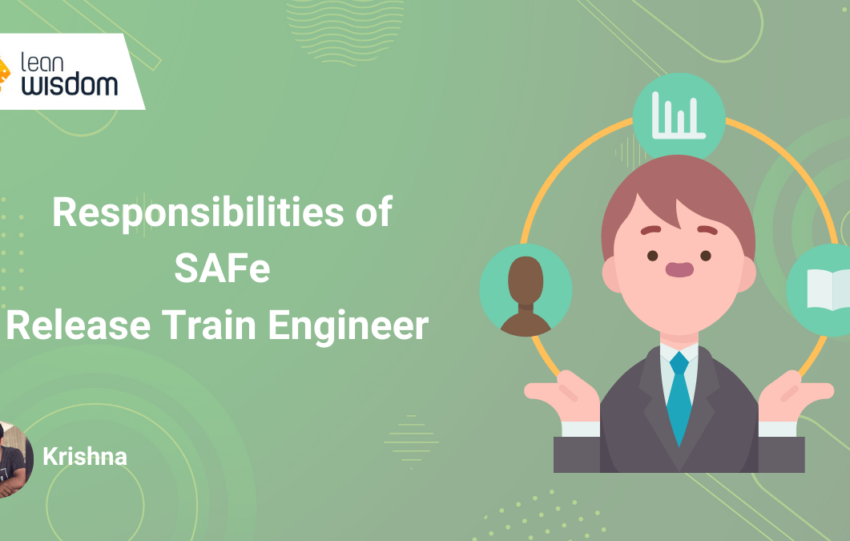
What Are the Responsibilities of a Release Train Engineer?

The Importance of Pre-Planning in SAFe
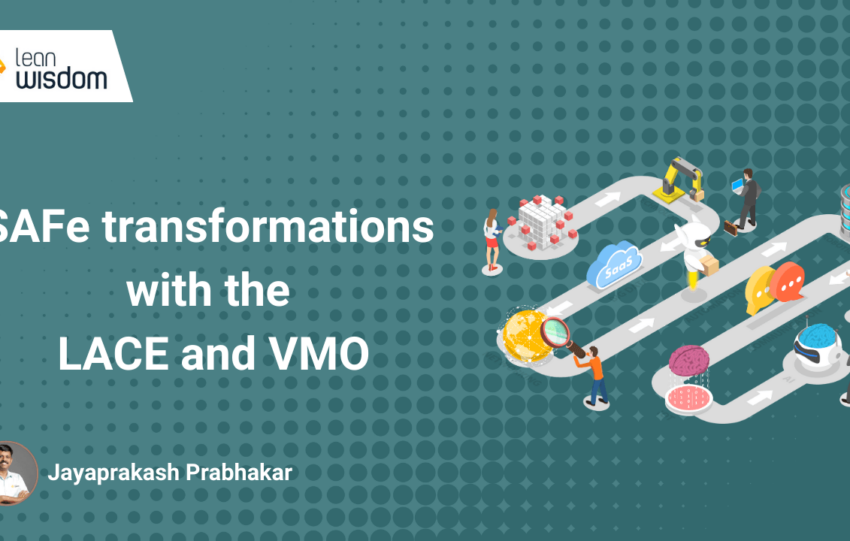
Coordinating SAFe transformations with the LACE and VMO

Aligning Product Strategy with Business Objectives
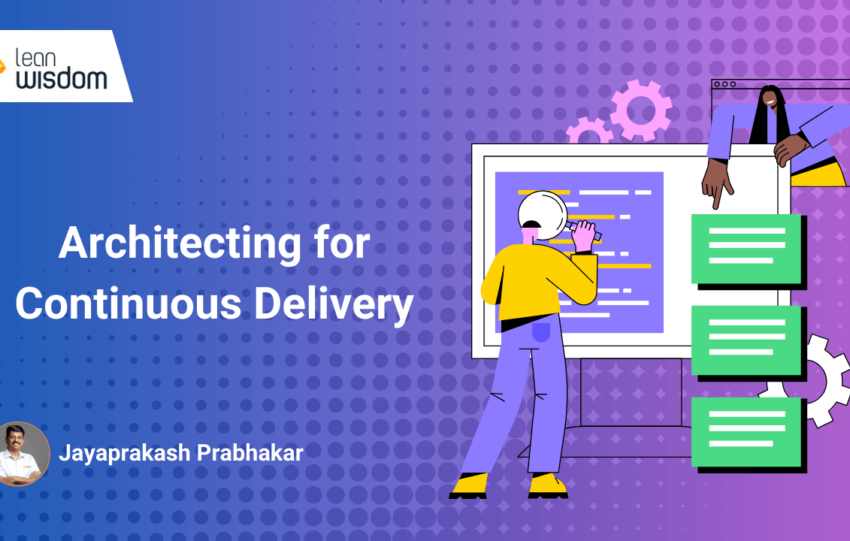
Architecting for Continuous Delivery
Drop Your Query


Five Things You May Not Know About the SAFe Inspect and Adapt (I&A) Event
The Scaled Agile Framework (SAFe … the “e” means nothing…) is the industry leading framework for scaling agile in a business or business unit. It’s used by some pretty big names like CVS, American Express, and FedEx.
Emma Ropski
The Scaled Agile Frame work (SAFe) incorporates methods, events, principles, and roles that agilists are already familiar with from Scrum, Lean, and XP. But SAFe is also novel, with its own unique concepts, roles, and events like the Inspect and Adapt (I&A) , a reflective all hands event that happens every quarter featuring a problem solving workshop.
The thing about SAFe events is, even if you know a bit about them, they can still be super mysterious. It’s like a nursing student who’s only read their textbook or a rock and roll fan who’s never been to a Grateful Dead concert. You really have to be there to get it.
Lucky for you, I have been there! Over ten times as both a participant and a facilitator! Here are a few misconceptions.
The I&A is more than just the problem solving workshop
People often use the term I&A to mean just the problem solving workshop. Though that is the main attraction of the 4-hour event, you’re missing some of the context setting that happens earlier in the agenda.
First, there’s a demo of the current state of the product, highlighting work done in the past quarter. Next, the group reviews select success and predictability metrics focusing on areas to improve. Then, some do a retrospective during the event time-box to brainstorm and form problem statements. And finally, we get to the problem solving workshop!
- Become THE Expert!
- Subscribe to ScatterSpoke's Newsletter for more expert advice, and recieve a FREE copy of our popular Icebreakers List.
- Become an Expert!
You don’t need to use an Ishikawa diagram!
An Ishikawa diagram, also known as a fishbone diagram, is recommended for small groups to use to visualize potential contributing causes of the problem to be solved. The group then explores the causes of the causes using the five whys technique to get to a root cause. (Say causes of the causes five times fast). Though it may seem excessive to some, going deeper helps ensure that we're tackling the disease and not just a symptom of it. The group then diverges and converges on a solution set.
This fishbone visualization combined with the described technique is recommended because it is effective and theoretically sound. But fishbone quarter after quarter can leave teammates uninspired and asking, “… is there anything besides fish on the menu?”
I’ve seen a few other approaches to keep things fresh and keep morale up. My first I&A problem solving workshop was unlike any other. They gave all randomly assigned groups this prompt: “ You have all the money and resources you desire… How do you take our company down?" Let’s just say the room was buzzing! Though not traditional by any means, this alternative method still met the purpose of the event: to reflect and identify ways to improve.
Problems don’t actually get solved in the workshop
With a name like “problem-solving workshop,” you’d think you solve problems. A more accurate name would be “problem exploring and solution proposal workshop,” but that really doesn’t have the same ring to it.
Let me explain. In the problem-solving workshop, the problems proposed should be experienced cross-team and are usually systemic. Their root causes often lie in culture, process, or environment. They’re big problems! Realistically, some could take years to properly solve.
The vast majority of the time-box in the workshop is allotted to identifying these root causes. Even with less time, groups tend to brainstorm multiple possible solutions and present their top ideas to the whole group. Since problems are big, often the first step in the solution is to explore the problem more.
So, what’s the point? In my opinion, the problem-solving workshop raises problems to the surface and gets the conversation started. The “solving” often takes some more time, coordination, and prioritization.
Some people can’t participate
…. because they facilitate! Scrum masters, coaches, and other volunteers are usually necessary to guide small groups through a typical problem solving workshop. Why? To avoid the chaos that can often occur in group discussions:
• dominating the conversation and others not feeling safe to share
• Groups getting off topic due to confusion or boredom
• Skipping “less exciting” steps like problem exploration to get to “more exciting” steps like solutioning
Still, knowing some teammates aren’t engaged in problem solving can feel like a disservice to the whole group. Everyone has experiences, knowledge, and context to add to the collective pool of knowledge which would contribute to a more holistic and, therefore, successful solution. My advice? Rotate facilitators every quarter when possible, especially if they aren’t in a dedicated coaching role.
It takes a lot of behind the scenes work to make the I&A happen.
Though many will just show up, listen, and problem solve with their teammates at the end of the quarter, the I&A event requires several people several hours to prepare for.
Product management is usually accountable for the demo though may get some support from scrum masters. They usually connect with teams, team leads, and feature-owners to coordinate a demo (ideally live and not death by PowerPoint) of the holistic product, highlighting new features delivered this quarter.
Good data doesn’t just happen; it’s quite intentional. Success and predictability metrics should be agreed upon and defined before the quarter, ideally as a constant to compare quarter to quarter. Once collected and visualized, it needs to be presented in a way that is concise and motivating regardless of the results. Not an easy task.
Retrospective
Running a 30-minute retrospective with 100 people on identifying and defining systemic problems experienced across several teams in the last 3 months is a tall task. With the teams I’ve been on, usually we’ve taken the extra step ahead of the I&A to gather problem statements. As the scrum master, I’d design and facilitate a retro of the past three months and coach teams through what’s an appropriate problem to bring and the information it needs. It’s still a tall task, but a little less tall. We could make the task even shorter by using ScatterSpoke’s Team Pulse 👀
Designing the format, forming the small groups, training the facilitators, collecting improvement items, voting on them, and finding a way to squeeze them into an already tight backlog is all in a day’s work for the coach leading this event. Just reading it all makes me sweat!
Even if you haven’t been there, with the inside scoop from me, the I&A in practice should be a bit demystified. It’s not just a problem-solving workshop. And the problem-solving workshop isn’t really a problem solving workshop. You can vary the protein served beyond fish, and not everyone gets to eat (but definitely next time!). Last but not least, preparing for the I&A takes time, energy, and passion. Systemic problems aren’t easy, but this unique SAFe event is an inclusive and brave first step toward solving them.
Related Posts
The power of developer feedback.
Listening to team feedback is essential in tech for building high-quality software and staying competitive. Developers and support teams provide practical, hands-on insights that can lead to immediate improvements. Creating a continuous feedback loop, acting on the feedback, and building trust within the team are critical steps for fostering a culture of continuous improvement and collaboration.
Why Quarterly Retrospectives Guarantee Nothing Ever Changes in Agile Release Trains
Quarterly feedback may align with SAFe's Program Increments, but it can hinder the success of Agile Release Trains. Discover how Agile Delivery Managers and RTEs can drive continuous improvement through frequent retrospectives and actionable insights. Learn why embracing agility and faster feedback loops is crucial for your organization's growth and success.
John Samuelson
How scatterspoke developers improved flow state time with ai coding assistant cody.
The developers at ScatterSpoke enhanced their flow state time and sped up their delivery process by integrating an AI coding assistant named Cody, which helped automate repetitive tasks, provide code suggestions, and quick-fix common errors. As a result, their workflow improved significantly with increased productivity, enhanced knowledge, improved focus, and reduced coding errors, leading to the delivery of high-quality software products.
Act On Feedback Faster
Join the ranks of data-driven companies seamlessly acting on feedback and driving substantial improvement with less effort.
ScatterSpoke helps you eliminate waste in your dev process.
© XXXX ScatterSpoke. All Rights Reserved.
Members-only Content
- Monthly Member Events
- Event Session Videos
- Experience Reports
- Research Papers
- Share a Community Event
- Submit an Article to the Blog
- Submit a Member Initiative
- Promote a Training Event

Become an Agile Alliance member!
Your membership enables us to offer a wealth of resources, present renowned international events, support global community groups, and so much more! And, while you’re supporting our non-profit mission, you’ll also gain access to a range of valuable member benefits. Learn more
- Join Us Today
- Member Portal
- Membership FAQs
- Terms and Conditions
- Corporate Members
Agile Conferences
- All Agile Alliance Events
- Past Conferences
- Become an Event Sponsor
Virtual Events
- Member Events Calendar
- BYOC Lean Coffee
- Agile Tech Talks
- Member Meet & Greet
- Agile Coaching Network
- Full Events Calendar
- Community Events
- Community Events Calendar
- Agile Training Calendar
- Sponsored Meetup Groups
- Submit a Non-profit Event
- Submit a For-profit Training
- Event Funding Request
- Global Events Calendars

Deliver Better Results: How to Level up Your Value Delivery
- Events Calendar
- BYOC – Lean Coffee
- Member Meet & Greet
- Agile Training
- View All Events
- Submit an Event
- Meetup Groups
- Past Conferences & Events
Agile Essentials is designed to bring you up to speed on the basic concepts and principles of Agile with articles, videos, glossary terms, and more.
Agile Essentials
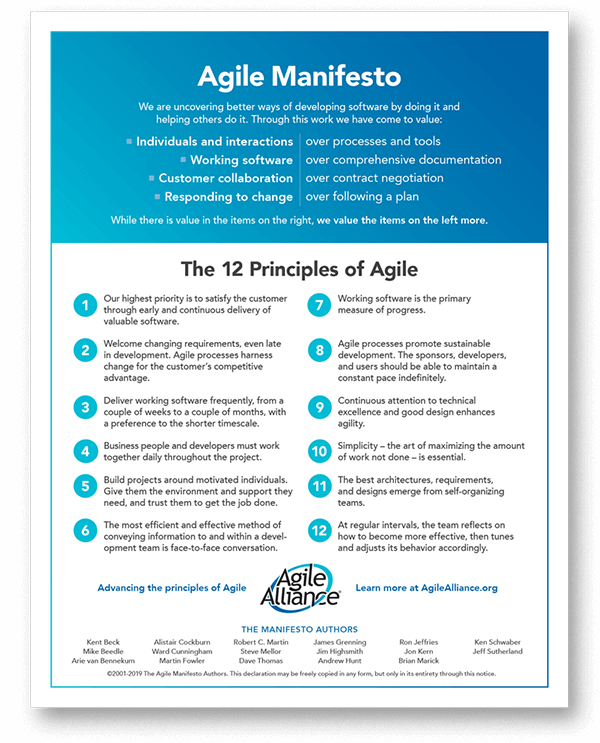
Download the Agile Manifesto
To download a free PDF copy of the Agile Manifesto and 12 Principles of Agile, simply sign-up for our newsletter. Agile Alliance members can download it for free.
- Agile Essentials Overview
- Agile Manifesto
- 12 Principles Behind the Manifesto
- A Short History of Agile
- Subway Map to Agile Practices
- Agile Glossary
- Introductory Videos
Recent Blog Posts

Research shows DevOps plays a vital role in workplace efficiency

Agile’s true potential: A call for unity and collaboration

Highlights from Agile2024 & The European Experience
View all blog posts

Agile Resources
The new agile resource guide.

Find Agile services and products from our member companies in our new Agile Resource Guide . Many listings in the guide feature exclusive offers just for Agile Alliance members. View the guide
- Remote Working Guide
- Event Sessions
- Content Library
Sustainability Manifesto
The Agile Sustainability Initiative has created the Agile Sustainability Manifesto in an effort to grow awareness about sustainability within the Agile community and inspire a more sustainable way of working. Read and sign now
MEMBER INITIATIVES
- Agile Sustainability Initiative
- Principle 12 Initiative
- Agile in Color Initiative
- Agile Coach Camp Worldwide
- Agile Coaching Ethics
View all initiatives
Your Community
Global development.
- LATAM Community
- India Community
Global Affiliates
- Community Groups
- Community Services
- Member Initiatives
- LATAM Community Development
- India Community Development
- Volunteer Signup

OUR POLICIES
Become a sponsor.
Being an Agile Alliance sponsor is a great way to introduce your company to our members to build awareness around your products and services. The Call for Agile2024 Sponsorships is now open, and there are great options and opportunities still available! Learn more >
- About Agile Alliance
- Code of Conduct
- Board of Directors
- Agile Alliance Brazil
- Agile Alliance New Zealand
- Policies, Reports & Bylaws
- Logo and Media Files
- Become a Sponsor
Agile Event Session
The sun never sets on the problem solving workshop, this video content is for agile alliance members only.
If you’re already an active member, please log in now .
To view this content, and gain access to many more valuable resources, conference discounts, and invitations to exclusive networking and learning events, please consider becoming an Agile Alliance member .
Abstract/Description
A fundamental agile principle is the team reflects at regular intervals how to become more effective. The SAFe Inspect and Adapt Problem Solving workshop is a wonderful opportunity for everyone on an Agile Release Train (ART) to reflect on becoming more effective. However, what happens when the ART teams are massively distributed, such that the Sun truly never sets on the ART? How do you provide everyone on the ART an opportunity to reflect and collaborate with others who have similar interests? How do you enable all to participate in the problem solving session, to raise and solve problems that are important to them, and not just the problems that are important and visible to “home base”? This is the situation we faced at a large multi-national petroleum company preparing to conduct their first SAFe problem solving workshop. This story describes the practices, the agenda, the tools, and the lessons learned from running an equitable problem solving workshop for a train on which the Sun never set.
Additional Resources
- Rochelle Tan
- Steve Adolph
Speaker(s) may be willing to present this session at local group meetings and other events.
- Conference or Event
- Session Type
- Audience Levels
More Agile Event Session Videos

Agile For Social Good

A 6 Month Cultural Transformation: The Penta Story

Stuck in the Middle With You: Coaching New Agile Leaders

Joy, Inc. in Japan!
Have a comment join the conversation, discover the many benefits of membership.
Your membership enables Agile Alliance to offer a wealth of first-rate resources, present renowned international events, support global community groups, and more — all geared toward helping Agile practitioners reach their full potential and deliver innovative, Agile solutions.
Thank you to our valued Agile Alliance Annual Partners
Our new Annual Partner Program offers a new and exciting level of engagement beyond event sponsorship.

Our Cornerstone Corporate Supporting Members
Our Corporate Supporting Members are vital to the mission of Agile Alliance. Click here to view all corporate members.
©2024 Agile Alliance | All Rights Reserved | Privacy Policy
©2024 Agile Alliance All Rights Reserved | Privacy Policy
Privacy Preference Center
Consent management.
- Welcome back!
Not yet a member? Sign up now
- Renew Membership
- Agile Alliance Events
- Agile en Español
- Agile en Chile
- Resources Overview
- Agile Books
- Content Library by Category
- Content Standards
- Privacy Policy
- Cookie Policy
Privacy Overview
| Cookie | Duration | Description |
|---|---|---|
| __cfduid | 1 month | The cookie is used by cdn services like CloudFare to identify individual clients behind a shared IP address and apply security settings on a per-client basis. It does not correspond to any user ID in the web application and does not store any personally identifiable information. |
| _csrf | session | This cookie is essential for the security of the website and visitor. It ensures visitor browsing security by preventing cross-site request forgery. |
| _GRECAPTCHA | 5 months 27 days | This cookie is set by Google. In addition to certain standard Google cookies, reCAPTCHA sets a necessary cookie (_GRECAPTCHA) when executed for the purpose of providing its risk analysis. |
| cookielawinfo-checbox-analytics | 11 months | This cookie is set by GDPR Cookie Consent plugin. The cookie is used to store the user consent for the cookies in the category "Analytics". |
| cookielawinfo-checbox-functional | 11 months | The cookie is set by GDPR cookie consent to record the user consent for the cookies in the category "Functional". |
| cookielawinfo-checbox-others | 11 months | This cookie is set by GDPR Cookie Consent plugin. The cookie is used to store the user consent for the cookies in the category "Other. |
| cookielawinfo-checkbox-advertisement | 1 year | The cookie is set by GDPR cookie consent to record the user consent for the cookies in the category "Advertisement". |
| cookielawinfo-checkbox-necessary | 11 months | This cookie is set by GDPR Cookie Consent plugin. The cookies is used to store the user consent for the cookies in the category "Necessary". |
| cookielawinfo-checkbox-performance | 11 months | This cookie is set by GDPR Cookie Consent plugin. The cookie is used to store the user consent for the cookies in the category "Performance". |
| gdpr[allowed_cookies] | 1 year | This cookie is set by the GDPR WordPress plugin. It is used to store the cookies allowed by the logged-in users and the visitors of the website. |
| JSESSIONID | session | Used by sites written in JSP. General purpose platform session cookies that are used to maintain users' state across page requests. |
| PHPSESSID | session | This cookie is native to PHP applications. The cookie is used to store and identify a users' unique session ID for the purpose of managing user session on the website. The cookie is a session cookies and is deleted when all the browser windows are closed. |
| pmpro_visit | The cookie is set by PaidMembership Pro plugin. The cookie is used to manage user memberships. | |
| viewed_cookie_policy | 11 months | The cookie is set by the GDPR Cookie Consent plugin and is used to store whether or not user has consented to the use of cookies. It does not store any personal data. |
| Cookie | Duration | Description |
|---|---|---|
| __atuvc | 1 year 1 month | This cookie is set by Addthis to make sure you see the updated count if you share a page and return to it before our share count cache is updated. |
| __atuvs | 30 minutes | This cookie is set by Addthis to make sure you see the updated count if you share a page and return to it before our share count cache is updated. |
| __jid | 30 minutes | Used to remember the user's Disqus login credentials across websites that use Disqus |
| aka_debug | This cookie is set by the provider Vimeo.This cookie is essential for the website to play video functionality. The cookie collects statistical information like how many times the video is displayed and what settings are used for playback. | |
| bcookie | 2 years | This cookie is set by linkedIn. The purpose of the cookie is to enable LinkedIn functionalities on the page. |
| CONSENT | 16 years 8 months 15 days 5 hours | Description Pending |
| disqus_unique | 1 year | Disqus.com internal statistics |
| lang | session | This cookie is used to store the language preferences of a user to serve up content in that stored language the next time user visit the website. |
| language | This cookie is used to store the language preference of the user. | |
| lidc | 1 day | This cookie is set by LinkedIn and used for routing. |
| locale | 3 days | This cookie is used to store the language preference of a user allowing the website to content relevant to the preferred language. |
| STYXKEY_aa_signup_visited | session | No description |
| Cookie | Duration | Description |
|---|---|---|
| _gat_UA-17319182-1 | 1 minute | Set by Google Analytics and Google Tag Manager to enable website owners to track visitor behaviour and measure site performance. These cookies are used to collect information about how you use our website. The information collected includes number of visitors, pages visited and time spent on the website. The information is collected by Google Analytics in aggregated and anonymous form, and we use the data to help us make improvements to the website. |
| YSC | session | This cookies is set by Youtube and is used to track the views of embedded videos. |
| Cookie | Duration | Description |
|---|---|---|
| _ga | 2 years | This cookie is installed by Google Analytics. The cookie is used to calculate visitor, session, campaign data and keep track of site usage for the site's analytics report. The cookies store information anonymously and assign a randomly generated number to identify unique visitors. |
| _gat_gtag_UA_17319182_1 | 1 minute | Set by Google Analytics and Google Tag Manager to enable website owners to track visitor behaviour and measure site performance. These cookies are used to collect information about how you use our website. The information collected includes number of visitors, pages visited and time spent on the website. The information is collected by Google Analytics in aggregated and anonymous form, and we use the data to help us make improvements to the website. |
| _gat_UA-0000000-1 | 1 minute | Set by Google Analytics and Google Tag Manager to enable website owners to track visitor behaviour and measure site performance. These cookies are used to collect information about how you use our website. The information collected includes number of visitors, pages visited and time spent on the website. The information is collected by Google Analytics in aggregated and anonymous form, and we use the data to help us make improvements to the website. |
| _gid | 1 day | This cookie is installed by Google Analytics. The cookie is used to store information of how visitors use a website and helps in creating an analytics report of how the website is doing. The data collected including the number visitors, the source where they have come from, and the pages visted in an anonymous form. |
| eud | 1 year 24 days | The domain of this cookie is owned by Rocketfuel. This cookie is used to sync with partner systems to identify the users. This cookie contains partner user IDs and last successful match time. |
| S | 1 hour | domain .google.com |
| uvc | 1 year 1 month | The cookie is set by addthis.com to determine the usage of Addthis.com service. |
| vuid | 2 years | This domain of this cookie is owned by Vimeo. This cookie is used by vimeo to collect tracking information. It sets a unique ID to embed videos to the website. |
| Cookie | Duration | Description | |||||||||||||||||||||||||||||||||||||||||||||||||||||||||||||||||||||||||||||||||||||||
|---|---|---|---|---|---|---|---|---|---|---|---|---|---|---|---|---|---|---|---|---|---|---|---|---|---|---|---|---|---|---|---|---|---|---|---|---|---|---|---|---|---|---|---|---|---|---|---|---|---|---|---|---|---|---|---|---|---|---|---|---|---|---|---|---|---|---|---|---|---|---|---|---|---|---|---|---|---|---|---|---|---|---|---|---|---|---|---|---|---|
| _fbp | 3 months | This cookie is set by Facebook to deliver advertisement when they are on Facebook or a digital platform powered by Facebook advertising after visiting this website. | |||||||||||||||||||||||||||||||||||||||||||||||||||||||||||||||||||||||||||||||||||||||
| AnalyticsSyncHistory | 1 month | Used to store information about the time a sync with the lms_analytics cookie took place for users in the Designated Countries | |||||||||||||||||||||||||||||||||||||||||||||||||||||||||||||||||||||||||||||||||||||||
| bscookie | 2 years | This cookie is a browser ID cookie set by Linked share Buttons and ad tags. | |||||||||||||||||||||||||||||||||||||||||||||||||||||||||||||||||||||||||||||||||||||||
| euds | session | These cookies are from Rocket Fuel (rfihub.com) and are used to deliver targeted advertising across their network sites ensuring users see relevant advertising. | |||||||||||||||||||||||||||||||||||||||||||||||||||||||||||||||||||||||||||||||||||||||
| fr | 3 months | The cookie is set by Facebook to show relevant advertisments to the users and measure and improve the advertisements. The cookie also tracks the behavior of the user across the web on sites that have Facebook pixel or Facebook social plugin. | |||||||||||||||||||||||||||||||||||||||||||||||||||||||||||||||||||||||||||||||||||||||
| IDE | 1 year 24 days | Used by Google DoubleClick and stores information about how the user uses the website and any other advertisement before visiting the website. This is used to present users with ads that are relevant to them according to the user profile. | |||||||||||||||||||||||||||||||||||||||||||||||||||||||||||||||||||||||||||||||||||||||
| loc | 1 year 1 month | This cookie is set by Addthis. This is a geolocation cookie to understand where the users sharing the information are located. | |||||||||||||||||||||||||||||||||||||||||||||||||||||||||||||||||||||||||||||||||||||||
| NID | 6 months | This cookie is used to a profile based on user's interest and display personalized ads to the users. | |||||||||||||||||||||||||||||||||||||||||||||||||||||||||||||||||||||||||||||||||||||||
| pxrc | 2 months | The purpose of the cookie is to identify a visitor to serve relevant advertisement. | |||||||||||||||||||||||||||||||||||||||||||||||||||||||||||||||||||||||||||||||||||||||
| rlas3 | 1 year | The cookie is set by rlcdn.com. The cookie is used to serve relevant ads to the visitor as well as limit the time the visitor sees an and also measure the effectiveness of the campaign. | |||||||||||||||||||||||||||||||||||||||||||||||||||||||||||||||||||||||||||||||||||||||
| rud | 1 year 24 days | The domain of this cookie is owned by Rocketfuel. The main purpose of this cookie is advertising. This cookie is used to identify an user by an alphanumeric ID. It register the user data like IP, location, visited website, ads clicked etc with this it optimize the ads display based on user behaviour. | |||||||||||||||||||||||||||||||||||||||||||||||||||||||||||||||||||||||||||||||||||||||
| ruds | session | The domain of this cookie is owned by Rocketfuel. This cookie is a session cookie version of the 'rud' cookie. It contain the user ID information. It is used to deliver targeted advertising across the networks. | |||||||||||||||||||||||||||||||||||||||||||||||||||||||||||||||||||||||||||||||||||||||
| sd-session-id | 1 year 24 days |

Inspect and Adapt (I&A): Driving Continuous Improvement in Agile ScrumInspect and Adapt (I&A) acts as a powerful tool in Agile Software Development. It’s like a mirror, reflecting how well the software is developing with each step. Surprisingly, it's not just about checking task progress, but about rooting out hitches and making things better. It's like tidying up your room regularly to keep it clean. Now, let us dive into understanding this principle even better. "Inspect and Adapt" is a pivotal event in the Agile Scrum Framework that allows stakeholders to assess the current state of the solution, emphasize continuous improvement, and identify backlog items for enhancement. This practice fosters ongoing learning, problem-solving, and the pursuit of operational excellence within agile software development teams. 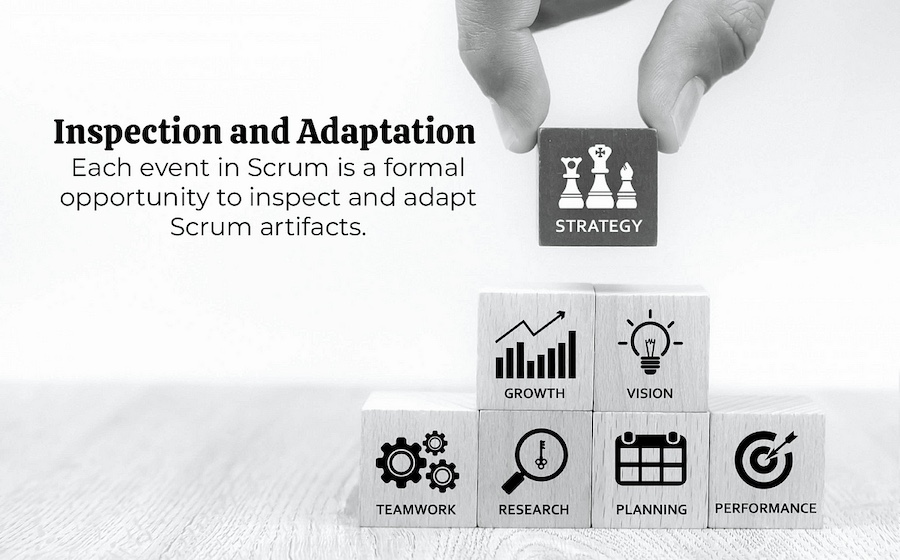 Understanding Inspect and AdaptInspect and Adapt (I&A) is not just a meeting or presentation; it is a critical event that drives continuous improvement in Agile software development. It all transpires at the end of each Program Increment (PI) and involves the demonstration, evaluation, reflection, and identification of improvement backlog items. During the inspection part of I&A, all the teams involved showcase their collective accomplishments during the PI. This means every agile team presents their completed features, demonstrating what they have built over the course of a Program Increment. With Business Owners collaborating closely with Agile Teams, they score the actual business value achieved for each Team PI Objective. The adapt part starts once the inspection is done. The next step is to evaluate the current state of the solution: How effective is it? What can be improved? Are there any underlying issues that need addressing? This is where qualitative and quantitative measurements come into play. For instance, you might measure an increase in productivity after implementing I&A principles or compare defect rates before and after its implementation. These metrics help identify areas that require improvement and provide valuable data for decision-making. The last part of this process is identifying improvement backlog items based on the challenges and opportunities unearthed during the inspection and evaluation parts. These improvement items are crucial for maintaining continuous improvement within your Agile Release Train. Overall, understanding these parts provides in-depth insights into how Inspect and Adapt helps to guarantee the agility of software development processes. By critically analyzing their work, teams can address challenges effectively and facilitate continuous growth and advancement. Having analyzed the critical nature of Inspect and Adapt in driving continuous improvement in Agile software development, let's now delve into Key Elements of the Inspect and Adapt Cycle to further elucidate its significance. Key Elements of the Inspect and Adapt CycleThe Inspect and Adapt (I&A) event in Agile Software Development consists of three crucial parts: the PI System Demo, Quantitative and Qualitative Measurement, and the Retrospective. Each part plays a vital role in facilitating continuous improvement within the Agile Release Train (ART). PI System DemoThe PI System Demo is a pivotal segment of the I&A event, where all the features developed during the Program Increment (PI) are put on display. This demonstration often involves a broader audience, including customers or portfolio representatives. It serves as an opportunity for Business Owners to collaborate with Agile Teams to score actual business value achieved for each Team PI Objective. In essence, the PI System Demo allows stakeholders to gain a comprehensive understanding of the tangible output realized during the PI. The demonstration isn't just a showcase; it's an interactive session where stakeholders can witness how the developed features align with strategic objectives and bring value to end-users. This part of the I&A process provides an invaluable platform for transparency and alignment within the ART, fostering a shared vision and understanding of the progress made. Quantitative and Qualitative MeasurementFollowing the PI System Demo, the I&A event transitions into a phase focused on quantitative and qualitative measurement. Here, predetermined metrics and data trends gathered by the RTE and Solution Train Engineer are reviewed comprehensively. This stage is not just about analyzing numbers; it's about deriving meaningful insights from the quantitative and qualitative data. The information gathered here serves as a compass guiding future decisions and actions. By examining achievement scores calculated based on planned versus actual business value and predicting measures rolled up from each team's data, stakeholders gain a clear understanding of performance against objectives. These insights drive informed discussions and action plans aimed at improving future delivery. RetrospectiveThe final component of the I&A event is the Retrospective, which holds significant importance in identifying improvement backlog items. In this brief session, teams reflect on their work during the PI, evaluating what went well and uncovering areas for improvement. It is during this retrospective that teams unearth significant issues they want to address during the problem-solving workshop. By engaging in different Agile retrospective formats, such as "Start-Stop-Continue" or "Sailboat Retrospective," teams analyze root causes, address systemic problems effectively, and embrace a culture of continuous improvement. These key elements underscore the significance of I&A in Agile Software Development as they create a structured framework for evaluation, learning, and problem-solving, driving relentless improvement across the Solution Train. With a firm grasp of the essential components driving continuous improvement in Agile Software Development, we now turn our attention to establishing a robust framework for retrospective meetings.  Firming Retrospective Meetings FrameworkRetrospective meetings are an integral part of Agile software development, where teams reflect on their performance and identify areas for improvement. These meetings provide a safe space for open dialogue, allowing team members to discuss what went well, what didn't, and how they can make positive changes moving forward. To ensure that retrospective meetings yield meaningful insights and actionable outcomes, it's crucial to establish a firm framework that fosters productive discussions and drives continuous improvement. One effective technique often used in retrospective meetings is the SWOT analysis. This approach helps teams evaluate their Strengths, Weaknesses, Opportunities, and Threats. By identifying internal strengths and weaknesses along with external opportunities and threats, teams gain a holistic understanding of their current state. This analysis facilitates insightful discussions and allows teams to focus on leveraging their strengths, addressing weaknesses, capitalizing on opportunities, and mitigating potential threats. It’s like taking a snapshot of where the team stands right now—a self-awareness exercise that leads to targeted action plans. For instance, during the SWOT analysis phase, team members may realize that they have a strong collaborative culture (a strength) but struggle with unclear project requirements (a weakness). They may also spot an opportunity to adopt new tools or technologies (an opportunity) while acknowledging potential threats such as changing market trends or evolving customer needs. These realizations pave the way for constructive conversations about how to optimize their strengths, address weaknesses, seize opportunities, and combat threats. Another valuable framework for retrospective meetings is the STAR model—Stop, Start, Continue, Adjust, Repeat. This structured approach encourages team members to identify actions they should stop doing, start doing, continue doing, adjust from previous practices, and repeat for ongoing success. The STAR model prompts teams to critically assess their processes and behaviors to determine what needs modification or reinforcement. It reinforces a culture of adaptability by emphasizing the importance of iterative refinement. Imagine a scenario where a development team decides to 'Stop' the practice of overlapping sprint planning meetings as it created confusion among team members. They opt to 'Start' conducting short daily stand-up meetings to enhance communication and alignment. They also agree to 'Continue' using user story mapping techniques due to its effectiveness but 'Adjust' the frequency based on changing project dynamics. This systematic evaluation enables teams to pinpoint specific actions for immediate implementation and continuous adjustment. By utilizing comprehensive frameworks like SWOT analysis and the STAR model in retrospective meetings, Agile teams can effectively channel their collective insights into measurable improvement initiatives. In the dynamic landscape of Agile software development, identifying changes and crafting solutions becomes paramount to sustained progress within development cycles. Identifying Changes and Crafting SolutionsAfter thorough discussions and retrospectives, the next critical step involves identifying changes and crafting solutions. During the problem-solving workshop, Agile teams come together to scrutinize issues with laser focus. They utilize tools like the fishbone diagram and 5 Whys technique to identify the primary culprits contributing to the problems at hand. The Fishbone Diagram and 5 Whys TechniqueThe fishbone diagram , or Ishikawa diagram, is instrumental in categorizing potential causes of a problem into specific branches, allowing for a structured approach to investigation. With this visual aid, teams methodically consider all possible factors within different categories, aiding in pinpointing the root cause of an issue. Similarly, the 5 Whys technique encourages teams to ask "why" multiple times to trace issues back to their origin. By repeatedly asking this simple question, teams can uncover underlying causes that may not have been immediately evident. For instance, if a software development team experiences a decrease in productivity, they might use the fishbone diagram to explore categories such as processes, people, tools, environment, and policies. By breaking down the various factors contributing to the decline in productivity, they can gain a comprehensive understanding of the issue. Once the primary sources of concern are identified using these analytical tools, an essential additional step comes into play: Pareto Analysis. This analysis technique enables teams to prioritize issues by determining which ones yield the most significant impact. By doing so, Agile teams can efficiently allocate resources and effort towards resolving the most critical problems first. Pareto Analysis is based on the Pareto principle, also known as the 80/20 rule. This principle highlights that roughly 80% of effects come from 20% of causes. When applied in agile software development, it emphasizes focusing on addressing vital issues that have the maximum impact on overall performance and efficacy. Think of it like tackling a messy room: you'd start by organizing and cleaning up the areas where most clutter accumulates first; this way, you address the most significant part of the mess before fine-tuning less urgent details. Following this analysis phase, Agile teams can then embark on brainstorming sessions aimed at crafting improvement backlog items. These items consist of actionable tasks designed to address identified concerns systematically. Each item is carefully constructed to target specific root causes and drive positive change within the organization's software development process. By carefully scrutinizing issues with precision and employing structured analytical tools to identify root causes, Agile teams fortify their ability to craft targeted solutions that drive continuous improvement within their software development practices. Strategies: Evaluation and RefinementThe PDCA cycle is a powerful concept that helps Agile teams evaluate the effectiveness of their solutions and make continuous improvements. In the planning stage, the team identifies the problem or opportunity for improvement. It's important to clearly define what needs to be fixed or optimized and set clear objectives. Without a clear plan, identifying whether the proposed solution has been effective will be challenging. Once the plan is set, it's time to implement it. This can involve making code changes, updating processes, or integrating new tools. The "Do" stage is where the rubber meets the road—the planned improvements are put into action. After implementing the changes, it's crucial to check their impact. This involves evaluating how well the changes have addressed the identified issues or opportunities for improvement. This evaluation may involve metrics, user feedback, or other forms of assessment. Based on the results of the "Check" phase, it's time to take action. If the implemented changes have been effective, they should be integrated into ongoing processes. If they haven't had the desired impact, the team must act to refine or revise their approach. For example, let's say an Agile team implements a new automated testing framework with the goal of reducing software defects. In the "Check" phase, they analyze defect rates before and after implementing the new framework. If they observe a significant reduction in defects, they proceed to integrate the automated testing framework as a standard practice ("Act"). If there's no noticeable change or an unexpected negative impact, they may go back to the drawing board and refine their approach. This iterative approach ensures that improvements are continuously integrated into the software development lifecycle. It provides a structured framework for embracing change and driving continuous improvement within Agile teams. Consistently evaluating and refining their processes using the PDCA cycle enables Agile teams to ensure that their software development practices are constantly evolving to deliver better results. 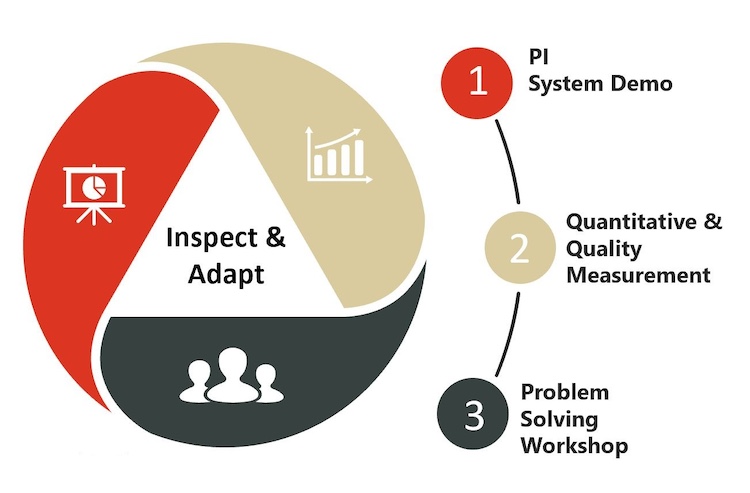 The Pivotal Role of I&A in Agile MethodologyIn the context of Agile methodology, the Inspect and Adapt (I&A) event isn't merely a formality; it's a cornerstone that forms the bedrock of relentless improvement and continuous learning. Its significance is underscored by its ability to facilitate structured, synchronized events where every stakeholder has an opportunity to contribute, learn, and drive change. But why is it so pivotal? Let's break it down. Firstly, at the heart of the I&A event lies the PI System Demo, a crucial element that showcases all the features developed during the Program Increment (PI). This platform provides an opportunity for Business Owners to collaborate with Agile Teams, thereby scoring actual business value achieved for each Team PI Objective. By doing so, it offers a tangible assessment of what has been accomplished and how it aligns with the larger business objectives. Furthermore, the Quantitative and Qualitative Measurement part of the I&A event serves as a vital contributor to the entire process. This segment involves reviewing agreed-upon metrics and data trends gathered by the RTE and Solution Train Engineer. Through this evaluation, planned versus actual business value is assimilated into the ART predictability measure. Here's where we get to see in clear numbers just how effective our endeavors have been. Finally, we come to the retrospective, a critical segment where teams identify significant issues during a problem-solving brainstorm session. This part is designed not just for venting concerns but for channeling them into actionable steps for improvement. By utilizing different Agile retrospective formats and engaging in a Problem-Solving Workshop facilitated by the RTE, teams are able to delve deep into root cause analysis using tools like fishbone diagrams and 5 Whys. Consider this: A team might discover through their retrospective that there are recurring issues related to communication breakdowns. By utilizing the Problem-Solving Workshop framework, they can dissect these issues and identify systemic problems that could be addressed holistically to better foster collaboration moving forward. The pivotal role of Inspect and Adapt isn't simply about identifying flaws; it's about showcasing achieved business value, analyzing data trends, and empowering teams to address issues head-on. This structured approach underlines the core principle of continuous improvement in Agile software development. Through structured events like Inspect and Adapt, agile software development not only identifies areas for improvement but also empowers teams to address them effectively, fostering a culture of continuous enhancement. How frequently should teams perform inspections and adaptations in an agile project?Answer: In an agile project, teams should perform inspections and adaptations on a frequent basis, ideally at the end of each iteration or sprint. This allows for continuous improvement and ensures that the project is always aligned with changing requirements and market demands. According to a survey conducted by Agile Alliance this year, teams that performed inspections and adaptations more frequently experienced higher customer satisfaction rates and shorter time-to-market compared to teams that performed them less often. Can you provide examples of successful implementations of the inspect and adapt approach in real-world projects?Answer: Sure! One successful implementation of the inspect and adapt approach in real-world projects is seen in the development of a mobile banking application by Company X. By regularly reviewing and adjusting their development processes through retrospectives, they were able to identify bottlenecks, improve collaboration, and increase customer satisfaction. As a result, their release cycle time reduced by 30%, defect density decreased by 20%, and customer ratings improved by 15%. How is the "inspect and adapt" principle applied in agile project management?Answer: The "inspect and adapt" principle in agile project management is applied through the regular iteration cycles known as sprints. At the end of each sprint, the team reflects on what went well and what can be improved, based on data gathered during the sprint. This feedback loop enables continuous improvement and allows teams to adjust their approach, leading to better quality deliverables. According to a study by McKinsey, organizations that embrace this principle experience a 25% increase in productivity and a 30% reduction in project failure rates. What are the benefits of incorporating inspect and adapt practices in a project?Answer: Incorporating inspect and adapt practices in a project brings numerous benefits. Firstly, it enables teams to continuously assess their progress and identify areas of improvement, leading to increased efficiency and productivity. Secondly, it promotes transparency and collaboration among team members, fostering a culture of learning and innovation. Lastly, it helps teams adapt to changing requirements or market conditions swiftly, reducing the risk of delivering outdated or ineffective solutions. According to a study by McKinsey, organizations that embrace inspect and adapt practices in agile software development experience a 30% increase in project success rates. Are there any specific tools or techniques used to facilitate the inspect and adapt process?Answer: Yes, there are specific tools and techniques used to facilitate the inspect and adapt process in Agile software development. Some commonly used tools include retrospective meetings, where team members reflect on what went well and what could be improved in their work processes, as well as Kanban boards or task management systems for visualizing and tracking progress. Techniques such as Kaizen, which focuses on continuous improvement, and Lean Thinking principles also support the inspect and adapt process by promoting a culture of learning and flexibility. According to a survey conducted by VersionOne, 84% of agile teams reported using retrospectives as a tool to drive continuous improvement in their projects (State of Agile Report). Which scrum event is used to inspect and adapt the scrum process?Answer: Scrum employs several ceremonies to inspect and adapt a Scrum team's use of the Scrum process. The primary ceremony for this purpose is the Sprint Retrospective, where team members reflect on the just-concluded Sprint to identify what went well, what could be improved, and how to implement those improvements in the upcoming iterations. Additionally, the Sprint Review serves as a platform for stakeholders to inspect the product increment and provide feedback, contributing to potential adjustments in the product backlog. Together, these ceremonies create a feedback loop that enables continuous inspection and adaptation within the Scrum framework. What are the four scrum inspect and adapt events?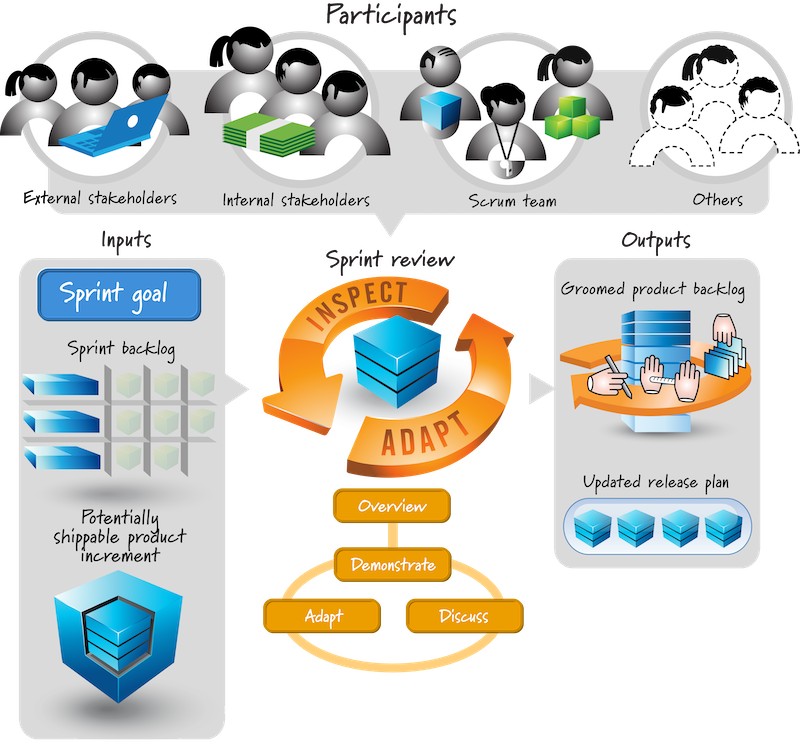 Answer: The four Scrum Inspect and Adapt events are Sprint Review, Sprint Retrospective, Product Increment Demonstration, and the Scrum of Scrums.
What is included in the inspect and adapt agenda?Key takeaways from scrum inspect and adapt.
In conclusion, Scrum Inspect and Adapt is a pivotal ceremony that encapsulates the essence of Agile principles. By focusing on product development, embracing change, and fostering a culture of continuous improvement, teams can elevate their Scrum practices and deliver higher value to their stakeholders.
Your Scrum Training Table of ContentsThe scrum framework - 3 rd edition, the scrum framework - 2 nd edition, we guarantee that your free online training will make you pass your scrum certification exam. 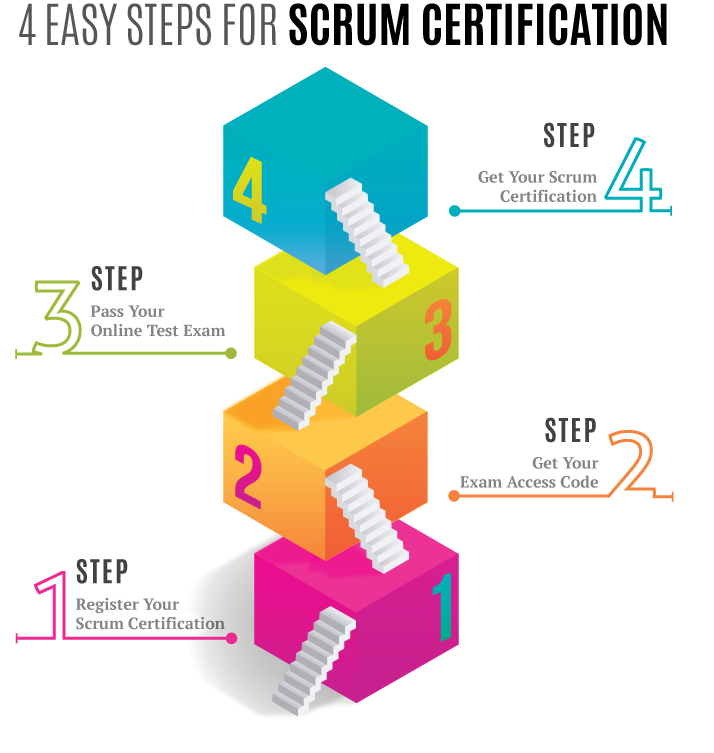 Get Your Free Scrum Book, Quickly Learn Scrum In Real Practice And Join 683,700 Scrum Professionals Bonus: Get Free Access To World's First Scrum AI Assistant --> In Only One Hour! The Scrum Framework 3rd Edition Is Now Ready. Get Special Bonuses (Last Day Today!) Click The Cover For Free Download...What is The Scrum Framework, 3rd Edition?
The Scrum Framework is a colorful, lively, and smart shortcut to help you deliver great results with Scrum (really fast and without hassle), so you can fuel the life and career you want. How can you access The Scrum Framework, 3rd Edition, and get started learning Scrum today? Although The Scrum Framework is the copyrighted intellectual property of the International Scrum Institute™, we wanted to make it freely accessible. We believe that only by sharing experience and know-how we've collected over the years, we can best serve Scrum professionals and the further development of the Scrum domain. Your Scrum certification examination comprises multiple-choice test questions. Reading The Scrum Framework will help Scrum professionals like you to acquire the know-how to pass your Scrum certification examination and get your Scrum certification. We GUARANTEE that The Scrum Framework will make you pass your Scrum certification exam!
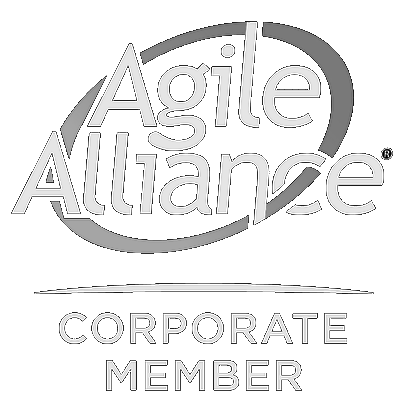
We are back in Europe and hope you join us! Prague, Czech Republic, 15 – 17, May 2023  Evolving the Scaled Agile Framework: Update to SAFe 5 Guidance for organizing around value, DevSecOps, and agility for business teams 
“A Scrum Master is like an orchestra conductor, guiding a group of individuals to create something that no one of them could create alone. —Mike Cohn Scrum MasterScrum master stories: yolanda. 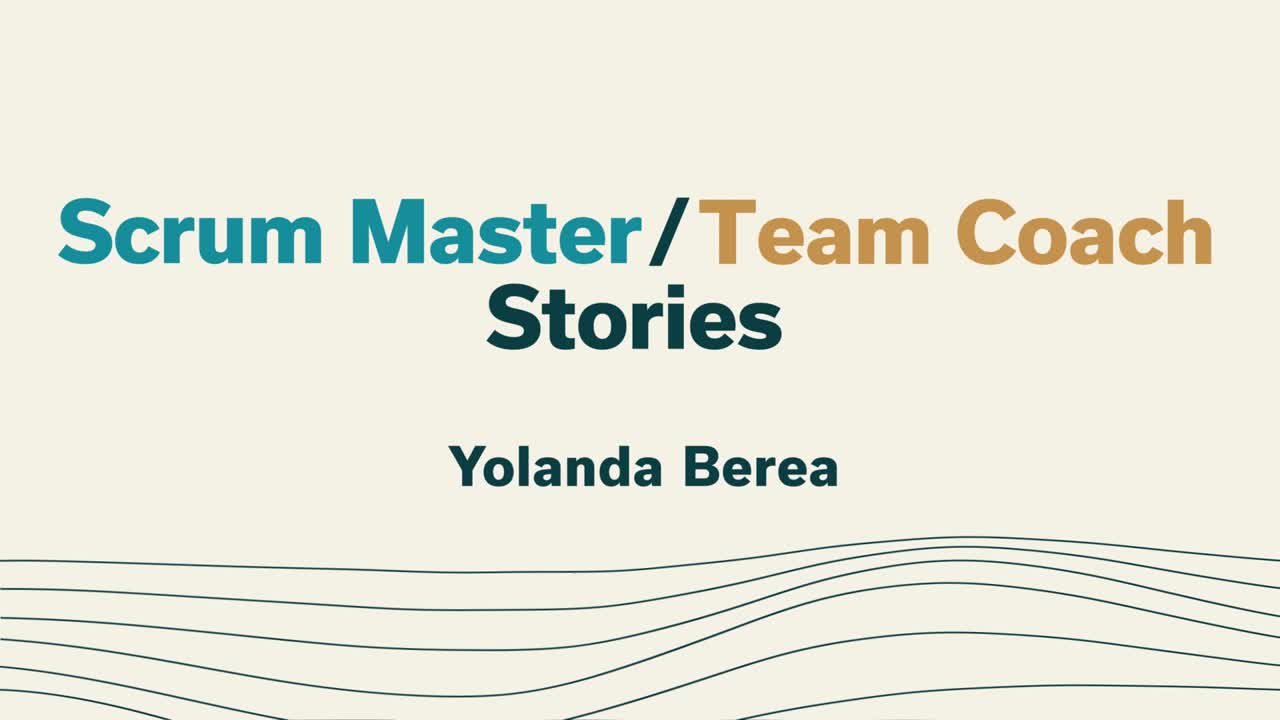 Find a Course :Implementing SAFe Leading SAFe SAFe for Teams SAFe Scrum Master SAFe Advanced Scrum Master SAFe Product Owner / Product Manager SAFe Release Train Engineer SAFe DevOps 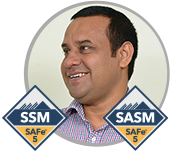 In SAFe, Scrum Masters assist their teams in meeting delivery goals. They coach teams in self-organization and self-management and help them coordinate and participate in Agile Release Trains (ARTs) events, increasing the effectiveness of SAFe across the organization. SAFe Scrum Masters are integral members of an Agile Team and share responsibilities for the team’s overall performance. Characteristics of a SAFe Scrum MasterThe SAFe Scrum Master role has the primary responsibility to help the team achieve its goals. They do this by teaching and coaching SAFe ScrumXP and SAFe, implementing and supporting SAFe principles and practices, and identifying and eliminating bottlenecks to flow. SAFe Scrum Masters come from various backgrounds and roles and are in high demand. But who makes a good Scrum Master? Although they are not typically people managers, they are influential members of an Agile Team. So, it’s important to know what characteristics make a good Scrum Master. For example, they often possess the following attributes:
Responsibilities of the SAFe Scrum MasterThe SAFe Scrum Master fulfills many critical responsibilities in performing the role, which is categorized in Figure 1. below. Each category is described in the sections that follow. 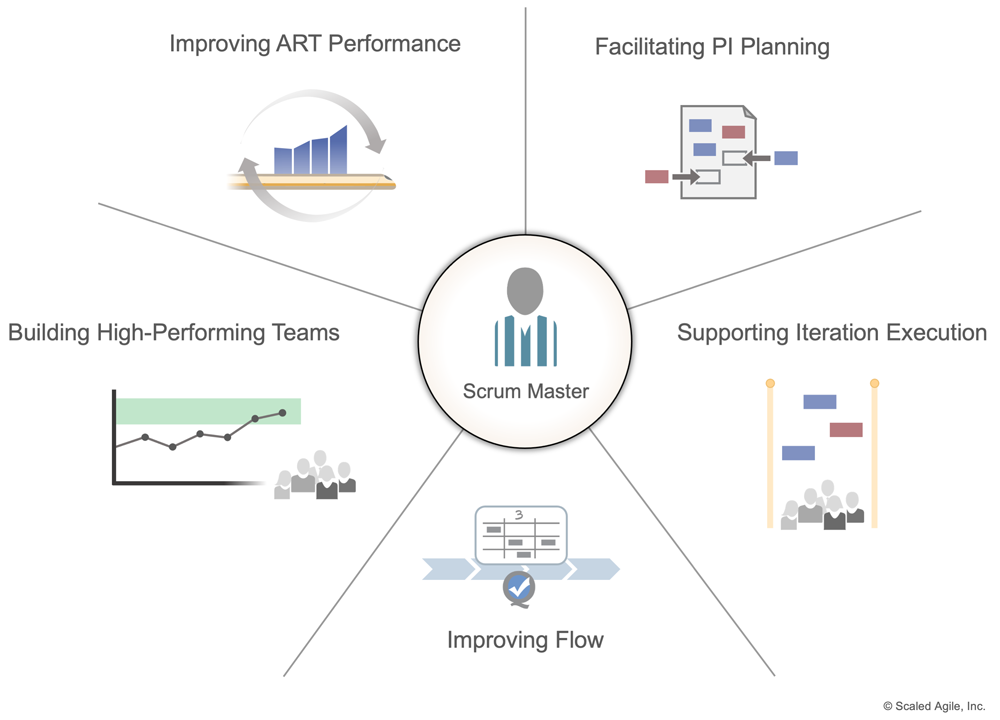 Facilitating PI PlanningSAFe Scrum Masters play an important role in PI Planning . Working with other Scrum Masters and the Release Train Engineer , they actively work with the team during PI planning to ensure a successful event. Prepare for PI PlanningBefore the event, the SAFe Scrum Master ensures the team is briefed on upcoming features by Product Managers , Business Owners , and other stakeholders, as illustrated in Figure 2. They help the team and the Product Owner identify local stories, maintenance, defects, tech debt, and other work the team needs to accomplish during the upcoming PI . 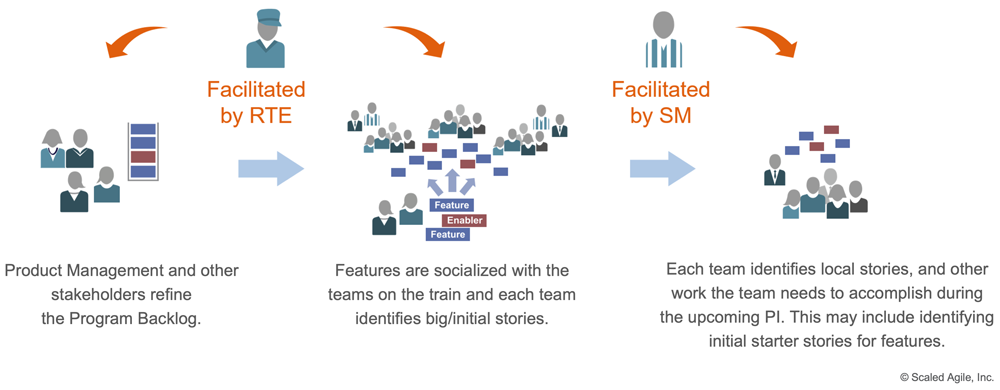 Draft PI PlansThe SAFe Scrum Master facilitates the team in creating a draft PI plan for the PI’s iterations, writing draft PI Objectives , and identifying program risks and issues. They also help the team set up their digital or physical planning areas, providing visual radiators that create transparency and collaboration. They help the team determine their capacity and keep within this constraint. Coordinate With Other TeamsSAFe Scrum Masters often play a lead role in ensuring cooperation and communication during the event. During PI planning, they usually secure subject matter experts (SMEs) and program stakeholders and foster communication with other teams to determine how they will collaborate on feature development and resolve dependencies. Create Team PI ObjectivesSAFe Scrum Masters help teams create team PI Objectives , which are the things they intend to accomplish in the upcoming PI. They ensure the objectives are written before the draft plan review and that a proper mix of committed and uncommitted goals are present. Review Final Plans and Business ValueBefore the final review, SAFe Scrum Masters help ensure PI objectives are smart (Specific, Measurable, Achievable, Realistic, and Time-bound) and are written in a way everyone can understand. The Scrum Master often facilitates Business Owners and team collaboration during business value assignments. Supporting Iteration ExecutionSAFe Scrum Masters support the team during the iteration, increasing the team’s likelihood of achieving its iteration goals and PI objectives, as illustrated in Figure 3. Facilitating Successful ScrumXP EventsScrum events create the heartbeat of Scrum, and the SAFe Scrum Master has a critical role in determining the success of each, as illustrated in Figure 3. Collaborating with the POSince the Product Owner is accountable for maximizing the value of the solution resulting from the team’s work, an essential aspect of the SAFe Scrum Master’s role is to support the PO as the team delivers value. They do this by:
Improving FlowEstablish the team kanban board. SAFe ScrumXP teams use Kanban systems to visualize the work and enhance flow. Implementing an effective Kanban system adapted to meet the needs of a specific Agile Team is based on the type of work performed (e.g., software development, marketing, hardware), the team members’ skills, and their role in the ART. Establishing the Team Kanban system is best done by involving the entire team with the guidance and facilitation of an experienced coach. The SAFe extended guidance article, Applying Kanban in SAFe , describes how to establish a Kanban system as well as how the Kanban systems are connected in SAFe. Figure 4 below illustrates an example of a Team Kanban board. 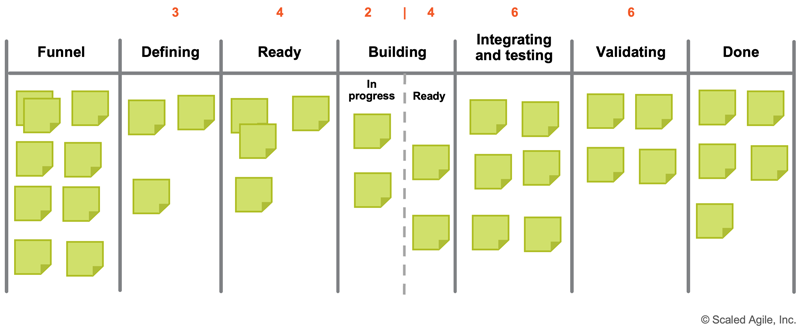 Measure and Optimize FlowSAFe Scrum Masters help the team establish a system of metrics to assess and improve its overall performance. Specific measures for Flow, Competency, and Outcomes are described in Metrics . Flow Metrics helps the Scrum Master and the team evolve its process iteratively and continuously adapt to fit the team’s needs. After defining the initial process and WIP limits and executing for a while, bottlenecks should become visible. If not, the team refines the process or further reduces some WIP limits until it becomes evident that a workflow state is overloaded or starving. Other coaching opportunities for optimizing flow might include merging or splitting steps, adding buffers, swim lanes and classes of service, or redefining workflow states. Build Quality InAgile Teams operate in a fast, flow-based system to quickly develop and release high-quality business capabilities instead of performing most testing at the end. The SAFe Scrum Master coaches Agile Teams to create and execute many tests early, often, and at multiple tiers. For example, unit tests are defined for code changes using Test-Driven Development (TDD), Behavior-Driven Development (BDD), and feature benefit hypothesis testing using Lean-UX are applied for Story, Feature, and Capability acceptance testing. Built-in Quality ensures that Agile development’s frequent changes do not introduce new errors and enables fast, reliable execution. Building High-Performing TeamsCreating healthy Agile Teams is essential to creating high-value increments of working solutions. Fortunately, many of the ingredients for high-performing teams are built into SAFe by design. For example, Agile Teams in SAFe are small, cross-functional, and self-organizing. They are empowered to define and execute the work needed to accomplish the team’s objectives and those of the ART. Everyone agrees that all increments should meet a shared, scalable definition of done. While every team is different, there are common characteristics that high-performing teams share. SAFe Scrum Masters are responsible for supporting and fostering the following team attributes:
Scrum Masters foster an environment for high-performing team dynamics, continuous flow, and relentless improvement. The Scrum Master mentors the team and creates an atmosphere of mutual respect, helping resolve interpersonal conflicts, and identifying growth opportunities. They assist the team in focusing on creating increments of high value for each iteration. Become a More Effective SAFe Scrum Master“Good leaders must first become good servants.” — Robert K. Greenleaf, father of servant leadership. Every servant leader knows that their growth comes from facilitating the development of others who deliver the results. Scrum Masters serve the team and the larger organization. The Scrum Master supports the overall adoption of SAFe across the enterprise by coaching stakeholders and non-agile teams on effective interactions with Agile Teams, participating in the Scrum Master Community of Practice, and supporting the organization’s SAFe Program Consultants (SPC). As Lean-Agile leaders , SAFe Scrum Masters also advance the adoption of SAFe, leading by example and incorporating the Lean-Agile Mindset and SAFe principles into how they behave and perform their responsibilities, providing training and coaching, and being role models for others to follow. Foster Collaboration on The TeamThe SAFe Scrum Master role fosters more effective and cohesive teams, enabling better business outcomes, solutions, and products. They offer observations, feedback, guidance, and advice based on what they know and have seen work. Coach with Powerful QuestionsHowever, SAFe Scrum Masters do not have all the answers. Instead, they can ask powerful questions to uncover what’s essential, then guide others to tap into their knowledge and expertise. Some examples of powerful questions include:
By asking questions this way, Scrum Masters help teams improve their performance, solve more problems independently, make better decisions, learn new skills, and reach their goals. Resolve Team ConflictsTeamwork is the ultimate competitive advantage. However, many teams are dysfunctional, according to Patrick Lencioni, consultant and author of Five Dysfunctions of a Team . In his book, Lencioni suggests that an absence of trust leads to the other four dysfunctions. SAFe Scrum Masters help address these five dysfunctions with the SAFe practices illustrated in Figure 5. Develop Team SkillsetsSAFe Scrum Masters work with team members and their functional managers to help them acquire T-shaped skills. A T-shaped individual has broad, general expertise in many areas and is an expert in one of these disciplines. They encourage team members to pair with others to expand their skills, take on tasks in another discipline and business domain, and participate in training courses and reading books to become continuous learners. Improving Program PerformanceSAFe Scrum Masters help teams improve the overall program performance through the following activities: Facilitate Cross-Team CollaborationCross-team collaboration is a hallmark of high-performing teams. Agile Teams need to cooperate across departments to bring whole product solutions to market. SAFe Scrum Masters nurture an environment where cross-team collaboration thrives and is supported by practices that offer opportunities for teams to work together, for example:
One of the significant benefits of working on and across teams is colleagues learn from one another. On an Agile Team, learning new skills makes everyone more valuable to the organization and better equipped to support each other’s work. It also guards against specialty skills becoming a bottleneck, which increases delays and reduces quality. Build Trust with StakeholdersThe SAFe Scrum Master helps the team build trust with stakeholders. SAFe relies on a rolling wave of short-term commitments from Agile Teams and ARTs to assist with business planning and outcomes, resulting in improved alignment and trust between development and business stakeholders. These are communicated via PI objectives. While solution development is uncertain by its very nature, the business depends on teams for some amount of reliable, predictable forecasting. Too little predictability and the business can’t plan. Too much, and the organization has committed to longer-term plans, which are unreliable and limit agility. Business and technology stakeholders need something in between, which is the primary purpose of PI objectives. Finish the PIThe end of each PI is a busy time for SAFe Scrum Masters. They often perform the following types of activities:
Full or Part-Time Role?The SAFe Scrum Master can be a part-time or full-time role, depending on the size of the team, the context, and other responsibilities. However, it can be challenging at the Enterprise scale to justify the need for a full-time Scrum Master for each Agile Team. SAFe takes a pragmatic approach, a team member sometimes takes the position with other duties, or they can support more than one team. However, during initial SAFe adoption, the job can be more intensive. It’s often beneficial to hire external Scrum Master consultants to mentor the teams and help them become experienced in Scrum and SAFe. These consultants will work with multiple teams and new Scrum Masters in the organization. And of course, to be effective, adequate training and experience are required. Last Update: 17 August 2022 Privacy Overview
Functional cookies help to perform certain functionalities like sharing the content of the website on social media platforms, collect feedbacks, and other third-party features. Performance cookies are used to understand and analyze the key performance indexes of the website which helps in delivering a better user experience for the visitors. Analytical cookies are used to understand how visitors interact with the website. These cookies help provide information on metrics the number of visitors, bounce rate, traffic source, etc. Advertisement cookies are used to provide visitors with relevant ads and marketing campaigns. These cookies track visitors across websites and collect information to provide customized ads. Other uncategorized cookies are those that are being analyzed and have not been classified into a category as yet.  | |||||||||||||||||||||||||||||||||||||||||||||||||||||||||||||||||||||||||||||||||||||||
IMAGES
COMMENTS
Pragmatic Bookshelf, 2009. Last update: 22 January 2023. The Inspect and Adapt (I&A) is a significant event held at the end of each PI, where the current state of the Solution is demonstrated and evaluated. Teams then reflect and identify improvement backlog items via a structured problem-solving workshop.
The Inspect and Adapt (I&A) is a significant event, held at the end of each Program Increment (PI), where the current state of the Solution is demonstrated and evaluated by the train. Teams then reflect and identify improvement backlog items via a structured, problem-solving workshop. The Agile Manifesto emphasizes the importance of continuous ...
SAFe Training Problem-Solving Workshop The Problem Solving Workshop is an Inspect and Adapt (I&A) event that provides a structured approach to identifying the root cause and actions to address systemic problems.
A problem-solving workshop is held by the Agile Release Train and its purpose is to address systematic problems. The workshop that concentrates on identifying the problems, not just addressing the symptoms, is facilitated by the Release Train Engineer and time-boxed to maximum of two hours. What are the six steps of the workshop? In SAFe ...
DevOps, Value Stream Mapping, and the Problem Solving Workshop are the coach's primary tools for enhancing these capabilities. The SAFe DevOps course can be used as a foundation for these practices during the first Innovation & Planning iteration or for continuing education during subsequent PIs as the need and opportunity dictate to ...
SAFe Problem-Solving Workshop The SAFE© Problem-Solving Workshop is an event from Scaled Agile Framework© that occurs within the Inspect and Adapt (I&A) event, which is held at the end of each Program Increment (PI). A PI is timebox during which an ART (a team of teams) delivers incremental value in the form of working, tested solution.
teams during the I&A. During this one-day workshop you will be guided through the planning, preparation and execution of the Inspect and Adapt workshop. Inspect and Adapt Workshop Optimize the quality of your implementation through relentless improvement 1 PI System Demo PI Quantitative Assessment Problem Solving Workshop 2 3 Scaled Agile ...
The SAFe® Problem Solving Board is a single template that guides agile teams and ARTs through each step of the Problem Solving Workshop. Instructions: 1. Original problem. Teams should state the problem, with the 'what', 'where', 'when', and 'impact' as succinctly as possible. Review all statements and move the problem that should be analyzed into step 2. 2. Root cause ...
The SAFe problem-solving workshop is part of the SAFe Inspect and Adapt event. General guidance for the problem-solving workshop is that it is about a two-hour process, where all members of the ART participate. This creates a fantastic opportunity for people to collaborate with others beyond their immediate team members. There is an implied ...
The Inspect & Adapt Workshop is more than a routine meeting; it's an opportunity for genuine growth. By focusing on process improvements, SAFe practitioners ensure that their Agile journey is not static but a path of continuous evolution and enhancement. Discover the pivotal outcomes of the Inspect & Adapt Workshop in the SAFe framework ...
Download this webinar to learn more about how to break through the barrier of virtual impediments and successfully run a virtual Problem Solving Workshop. The problem solving workshop should focus on large issues that have affected multiple teams, for example: Environmental issues that have impacted the teams; Teams colliding with each other ...
As part of the ART and Solution Train Inspect & Adapt events, SAFe builds problem-solving into Agile team retrospectives, and into the problem-solving workshop. Figure 4. The PDCA problem-solving cycle scales from individual teams to entire organizations Reflect at Key Milestones.
The tools used during the problem-solving workshop include Pareto analysis, Fish-bone or Ishikawa diagram, and/or 5Whys technique. With this exercise, the cycle of relentless improvement comes alive. Adopting Lean-Agile thinking and practices takes time and many of the best methods. And the SAFe Inspect and Adapt is a crucial part of it.
ART comes together and conducts this workshop to identify 1-2 key problems, find root causes and find solutions for the root causes. This is a six-step process. The whole process takes approximately 4 hours for the entire ART. Let's quickly look at each step. Agree on the problem to solve; A well stated problem is half-problem solved.
The SAFe Scrum Master/Team Coach (SM/TC) is a servant leader and coach for an Agile team who facilitates team events and processes, and supports teams and ARTs in delivering value. ... Facilitate the problem-solving workshop - SM/TCs coach teams in root cause analysis, the 'five whys,' [5] and Pareto analysis [6]. They ensure that the ...
And the problem-solving workshop isn't really a problem solving workshop. You can vary the protein served beyond fish, and not everyone gets to eat (but definitely next time!). Last but not least, preparing for the I&A takes time, energy, and passion. Systemic problems aren't easy, but this unique SAFe event is an inclusive and brave first ...
This is the situation we faced at a large multi-national petroleum company preparing to conduct their first SAFe problem solving workshop. This story describes the practices, the agenda, the tools, and the lessons learned from running an equitable problem solving workshop for a train on which the Sun never set. Add to Bookmarks.
This provides a much wider perspective of the problem, as well as a larger pool of creative solutions. Next, a problem-solving workshop begins with a root-cause analysis to help separate the actual cause from the symptoms. Here, several different tools can be used: A fishbone or "Ishikawa" diagram to identify the root causes of events
Conclusion on the SAFe Scrum Master's responsibilities in facilitating the Problem Solving Workshop. SAFe keeps the SAFe Scrum Master close to the ball and the players, ensuring certain ...
Solution Trains often hold an additional management review and problem-solving workshop after the first day of planning to address cross-ART issues. Alternatively, the RTEs of the involved trains may talk with each other to discuss the problems for the ART's specific management review and problem-solving meeting. ... SAFe 5.0 Distilled ...
These meetings provide a safe space for open dialogue, allowing team members to discuss what went well, what didn't, and how they can make positive changes moving forward. ... By utilizing different Agile retrospective formats and engaging in a Problem-Solving Workshop facilitated by the RTE, teams are able to delve deep into root cause ...
Tools and techniques like the Problem-Solving Workshop in SAFe can help determine the fact-based root cause of inefficiencies and lead to effective countermeasures that can be applied rapidly. Root cause analysis is exponentially more effective when supported by data. The self-assessments described in Measure and Grow provide one type of data ...
SAFe Scrum Masters are servant leaders and coaches for an Agile Team. They help educate the team in Scrum, Extreme Programming (XP), Kanban, and SAFe, ensuring that the agreed Agile process is followed. ... Facilitate the problem-solving workshop. Scrum Masters provide coaching in root cause analysis, the 'five why's,' and Pareto analysis.